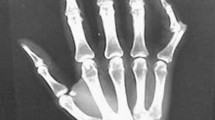Abstract
Palmar dislocation of the metacarpophalangeal (MCP) joint of the long finger represents a rare event. The first case was published by Mc Laughlin in 1965, and only nine other cases have been reported. We present one more case and discuss the mechanisms of these dislocations and treatment.
Case report: A 22-year-old biker presented with complex injuries of his right hand after a road accident.
Examination revealed an extensive palmar wound on the ulnar side of his right hand, with another on the MCP joint of the little finger, and shortening of the little and the ring fingers. Any attempt at active movement was impossible.
Roentgenograms showed a palmar dislocation of the MCP joint of the ring finger and a very displaced fracture of the fifth metacarpal head.
During surgery we observed on the ring finger a tear of the distal membranous attachment of the volar plate on the base of proximal phalanx, entrapped in the MCP joint, with an ulnar dislocation of the flexor tendons. On the little finger we observed a complex fracture of the fifth metacarpal head and a lesion of the ulnar collateral nerve. After opening the A2 pulley we repaired the volar plate by fixing it with 2 sutures through the base of the proximal phalanx and the metacarpal head fracture by a difficult open reduction and fixation with an axial pin. At the end of the operation, the fingers were immobilized on a palmar block splint for one month.
Passive range-of-motion exercises were started after one month and active excercises after two months. Now, one year after initial injury, the patient has recovered complete function of the MCP joints of the two fingers.
Discussion: Many different mechanisms can be discussed to explain this rare lesion. According to our case report we think that this dislocation was assumed to occur by hyperextension and translational force applied to the dorsum of the proximal phalanx. Like Wood [8] and Kaplan [3] we stress the importance of this translational force : a purely forced movement on the MCP joint generally causes a dorsal dislocation.
Entrapment of the volar plate in the MCP joint is the most common mechanism for irreductibility of the dislocation (Renshaw [7],Betz [1]), but in some other cases the irreductibility of the dislocation was linked to the entrapment of the dorsal capsule of the MCP joint.
A surgical approach is required in all cases where easy closed reduction is impossible. The operative approach depends on the mechanism of dislocation, but a palmar approach is preferred when no mechanism is defined. Indeed this route allows us to control the volar plate and possibly its repair or stabilisation.
A sound and solid repair of these lesions seems very important to stabilize the MCP in the long term joint. Earlier range-of-motion exercises are recommended for complete rehabilitation of the MCP joint.
Résumé
Un cas de luxation palmaire de l’articulation métacarpophalangienne du 4ème doigt chez un patient de 22 ans est rapporté. Le mécanisme présumé est une hyperextension, associée à une force de translation imprimée à la face dorsale de P1. La plaque palmaire incarcérée a empêché la réduction par manoeuvres externes. Cette lésion rare nécessite le plus souvent une réduction à foyer ouvert. Le choix de la voie d’abord est dicté par le mécanisme lésionnel, avec un abord palmaire préférentiel si celui-ci n’est pas précisé.
Similar content being viewed by others
Bibliographie
Betz RR, Browne EZ, Perry GB, Resnick EJ (1982) The complex volar metacarpophalangeal joint dislocation. A case report and review of the literature. J Bone Joint Surg 64-A: 1374–1375.
Hargarten SW, Hanel DP (1992) Volar metacarpal phalangeal joint dislocation: a rare and often missed injury. Ann Emerg Med 21: 1157–1159
Kaplan ED (1957) Dorsal dislocation of the metacarpophalangeal joint of the index finger. J Bone Joint Surg 39-A: 1081–1086
Khuri SM, Fay JJ (1986) Complete volar metacarpophalangeal joint dislocation of a finger. J Trauma 26: 1058–1060
Mc Laughlin HL (1965) Complex “locked” dislocation of the metacarpophalangeal joint. J Trauma 5: 683–688
Minami A, Katoh S, Minami M (1989) Luxation palmaire de la métacarpophalangienne. Rapport d’un cas et revue de la littérature. Rev Chir Orthop 75: 53–55
Renshaw TS, Louis DS (1971) Complex volar dislocation of the metacarpophalangeal joint: a case report. J Trauma 13: 1086–1088
Wood MB, Dobyns JH (1981) Chronic complex volar dislocation of metacarpophalangeal joint. J Hand Surg 6: 73–76
Author information
Authors and Affiliations
Rights and permissions
About this article
Cite this article
Paul, H., Albouni, S., Mauger, S. et al. La luxation palmaire de l’articulation métacarpophalangienne des doigts longs A propos d’un cas. Eur J Orthop Surg Traumatol 5, 97–100 (1995). https://doi.org/10.1007/BF02716249
Received:
Accepted:
Issue Date:
DOI: https://doi.org/10.1007/BF02716249




